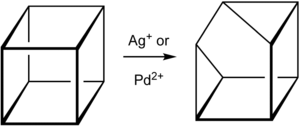Cuneane

| |
| Names | |
|---|---|
| Preferred IUPAC name
Pentacyclo[3.3.0.02,4.03,7.06,8]octane | |
| Identifiers | |
3D model (
JSmol ) |
|
| ChemSpider | |
PubChem CID
|
|
CompTox Dashboard (EPA)
|
|
| |
| |
| Properties | |
| C8H8 | |
| Molar mass | 104.152 g·mol−1 |
| Density | 1.578 g/ml |
Except where otherwise noted, data are given for materials in their standard state (at 25 °C [77 °F], 100 kPa).
| |
Cuneane (from
metal-ion-catalyzed σ-bond rearrangement.[2][3] Similar reactions are known for homocubane (C9H10) and bishomocubane (C10H12).[4][5]
Molecular geometry
The carbon atoms in the cuneane molecule form a hexahedron with point group C2v. The cuneane molecule has three groups of equivalent carbon atoms (A, B, C), which have also been confirmed by
NMR.[6] The molecular graph of the carbon skeleton of cuneane is a regular graph with non-equivalent groups of vertices, and so it is a very important test object for different algorithms of mathematical chemistry.[7][8]
Derivatives
Some cuneane derivatives have liquid crystal properties.[9]
References
- .
- ISBN 0-471-58589-0.
- .
- .
- .
- .
- S2CID 95809728.
- S2CID 98716956.
- S2CID 97269476.


